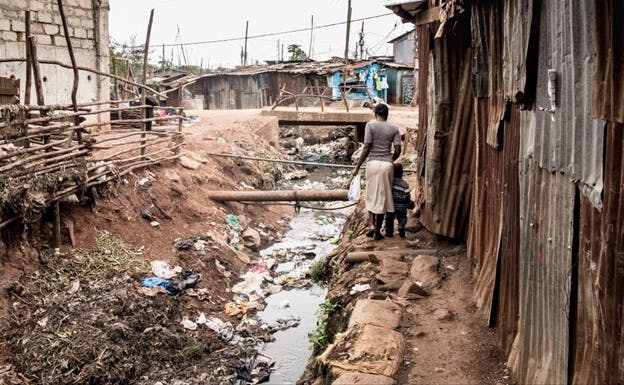February 2024
5 Ways to Avoid Getting Cholera Abroad
If you live in the United States or Canada, there’s a good chance you don’t think about infectious diseases like cholera much. Cholera used to be a major public health problem responsible for countless deaths, but modern sanitation infrastructure and personal hygiene habits have made it a rare occurrence.
That doesn’t mean it’s gone, however. In fact, there are still many cases in the U.S. each year, and major outbreaks are occurring throughout the world. Recent global travel patterns and climate changes have also played a role in the sporadic re-emergence of cholera in unexpected locations, reminding us of its continued relevance.
In this article, we’re going to take a deep dive into what cholera is, how it gets around, and how big of a threat it is to you and your loved ones.
What Is Cholera and What Causes It?
Cholera is a very dangerous infectious disease of the small intestines characterized primarily by severe diarrhea and dehydration. It is caused by ingesting water or food contaminated with the bacterium Vibrio cholerae. While the disease is mostly preventable, it continues to be a health concern in many parts of the world, particularly in areas with poor sanitation facilities and where access to clean water is lacking. On average, there’s one new case of cholera every 10 seconds worldwide.
Vibrio cholerae thrives in environments with poor water sanitation and water supplies that can be contaminated by feces. The bacterium also spreads in warm, brackish water and can be picked up through eating raw, undercooked seafood and shellfish caught there.
Historically, cholera has been responsible for significant global pandemics, but today, it is mostly confined to regions where water quality and sanitation are compromised. Despite the presence of modern sanitation and water treatment methods in many parts of the world, cholera outbreaks still happen, largely driven by factors such as poverty, lack of infrastructure, conflicts, and natural disasters that disrupt regular water supplies. Now climate change is compounding the issue.
What Are Common Symptoms of Cholera?
While most cases are mild or asymptomatic, severe cases can escalate to potentially fatal levels. About 10% of those infected with cholera suffer from severe symptoms. Initially, these include:
- Intense watery diarrhea, often likened to "rice-water" in appearance
- Frequent vomiting
- Intense thirst
- Muscle cramps in the legs
- Agitation or irritability
- A noticeably faster heartbeat
- Reduced skin elasticity
- Dryness in the mouth and other mucous membranes
- Decreased blood pressure
Cholera cases can rapidly progress to severe dehydration, potentially causing kidney failure. Without prompt treatment, this level of dehydration can lead to shock, unconsciousness, and death in just a few hours. If successfully treated, the bacteria doesn’t stick around for long but the person can be reinfected if exposed again.
How Is Cholera Transmitted from Person to Person?
When a cholera patient becomes infected, the bacteria proliferates in their intestines and is expelled in their feces. The diarrhea characteristic of cholera is heavily laden with infectious V. cholerae, making the spread of the disease possible to caretakers or anyone close to the infected person. It’s critical that all safety precautions are followed like hand washing and proper disposal of waste in a place where it can’t contaminate food, water, or surfaces.
Where in the World Is Cholera a Major Threat?
Cholera, largely eliminated from industrialized nations like the U.S. and Canada, remains a significant concern in developing countries worldwide. In the U.S., cholera became rare following advancements in water and sewage treatment systems since the 1800s. Today, nearly all U.S. cholera cases are acquired during international travel to areas with ongoing outbreaks, such as parts of Africa, Southeast Asia, or Haiti. Notably, during outbreaks near the U.S., like Haiti in 2010 and Latin America in the 1990s, domestic cholera cases saw an increase. Additionally, cholera infections in the U.S. have occasionally resulted from contaminated seafood imports.
Despite its near elimination from industrialized nations, the risk of cholera is still a significant health concern in many African countries. Sub-Saharan Africa has consistently reported the highest number of cholera cases and deaths, particularly from the late 1990s through the early 21st century. The region's high cholera mortality rate reflects inadequate access to basic healthcare, as most cases can be effectively treated with simple rehydration therapy.
In Bangladesh, India, and other Southeast Asian countries, large populations are at risk for cholera. Despite a decrease in reported cases, cholera-related deaths increased significantly from 2015 to 2016. The region faces many risk factors for cholera outbreaks, like poverty, underdevelopment, high population density, and environmental challenges like frequent flooding, which can contaminate water sources.
How Can You Prevent Cholera in Areas with Poor Water Quality?
According to the Centers for Disease Control and Prevention (CDC), preventing the spread of cholera is about avoiding contact with it anywhere you can. Here are some tips to protect yourself and those around you if an outbreak is happening where you are.
Use Bottled or Treated Water
If the water around you could be infected, use sealed bottled water for drinking, brushing teeth, washing and preparing food, and making ice. If bottled water isn't available, boil, chlorinate, or filter the water using a device with a pore size of 0.3 microns or less, like a reverse osmosis system.
Wash Your Hands Well and Often
Hand hygiene is critical to limiting cholera transmission. Wash your hands frequently with soap and safe water, particularly before and after handling food, using the toilet, and caring for those with diarrhea. If soap and water are unavailable, use an alcohol-based hand sanitizer containing at least 60% alcohol.
Dispose of Waste Properly
Infected waste can easily cause contamination in water and food. Use toilets or other managed sanitation facilities to dispose of feces. If toilets aren't available, defecate at least 30 meters away from water sources and bury the waste. Avoid using plastic bags for waste disposal in chemical toilets.
Practice Food Safety
Food safety is also important. Cook food thoroughly, especially seafood, and eat it while it's still hot. Avoid raw vegetables and fruits that can't be peeled. Keep food covered to prevent contamination.
Clean All Surfaces and Kitchenware
Finally, clean kitchenware with soap and treated water, and disinfect surfaces that might be contaminated with fecal matter. Bathe and wash clothes or diapers away from drinking water sources to prevent contamination.
How Important Is Clean Drinking Water in Preventing Cholera?
Contaminated water is at the center of most cholera epidemics. Having access to large amounts of clean water is essential in preventing its spread. Clean water disrupts the transmission cycle of cholera, which thrives in environments with poor sanitation and unsafe water sources.
In parts of the world where water purification systems are implemented, the incidence of cholera significantly decreases. This shows the importance of investing in water treatment facilities, promoting hygiene education, and ensuring the community's adherence to safe water practices.
Ultimately, the availability of clean, safe drinking water is not just a preventative measure against cholera but a cornerstone of public health, particularly in vulnerable communities where the risk of outbreaks is high.
Are Vaccines for Cholera Available? Should You Get One?
Yes, vaccines for cholera are available and can be an important tool for prevention, especially for those traveling to areas with active cholera transmission. The CDC recommends discussing cholera vaccination with your doctor if you plan to travel to such areas.
In the United States, the FDA-approved Vaxchora is a single-dose, oral vaccine suitable for individuals aged 2-64. It is reported to reduce the chance of moderate and severe diarrhea by 90% at 10 days post-vaccination and 80% after three months. However, the duration of protection beyond three to six months is not clearly known.
Globally, the World Health Organization (WHO) has approved other oral cholera vaccines, such as Dukoral, ShanChol, and Euvichol-Plus/Euvichol. These vaccines are not available in the U.S. but are used in other parts of the world. Dukoral requires two doses (three for children aged 2-5) and offers protection for about two years. ShanChol and Euvichol-Plus, which share the same formula but are produced by different manufacturers, also require two doses and provide at least three years of protection.
Whether to get vaccinated depends on factors like travel plans to affected areas and personal health considerations. Consult with a healthcare provider for personalized advice.
How Is Cholera Diagnosed and Treated?
Diagnosing cholera often involves testing a stool sample, as it is challenging to distinguish cholera from other causes of acute watery diarrhea without laboratory testing. The gold standard for diagnosing cholera is the isolation and identification of Vibrio cholerae serogroup O1 or O139 by culture of a stool specimen. Rapid tests like the Crystal VC dipstick are used in epidemic settings, but they should always be confirmed with traditional culture-based methods for accuracy.
The cornerstone of treating cholera is rehydration therapy. Fluid replacement is vital for survival. More than 99% of cholera patients survive with timely rehydration therapy. This treatment includes oral rehydration salts, intravenous fluids if necessary, and electrolytes to replenish what’s lost through diarrhea.
In addition to intravenous and oral rehydration solutions, the use of antibiotics and zinc have been found to be valuable in some circumstances.
How Are Global Health Organizations Combating Cholera?
Global health organizations are actively engaged in combating cholera through a multi-faceted approach. This includes promoting access to clean water and improved sanitation, supporting cholera vaccination campaigns, and enhancing surveillance and rapid response systems to detect and control outbreaks.
Organizations like the World Health Organization and UNICEF collaborate with national governments and local communities to implement WASH (Water, Sanitation and Hygiene) programs. Additionally, they provide technical assistance and resources for effective treatment and public health education to raise awareness about cholera prevention and control measures. These combined efforts aim to reduce the incidence of cholera and mitigate its impact on vulnerable populations.
Combat Cholera and Other Water Contaminants the Smart Way
While cholera has been largely solved in the industrialized world, in places without adequate sanitation or access to clean water, it remains a major public health problem. If you plan to travel to one of these places, talk to your doctor about a cholera vaccine and take precautions like using bottled water and washing your hands frequently while you’re there.
When you turn on your tap, cholera is probably the last thing on your mind, but that doesn’t mean your water is free of contaminants. If you’d like only the most pure and delicious water coming from your faucet, HomeWater can help. Our American-made UPSTREAM™ 4-Stage Whole Home Water Filter protects every tap in your home from dirt, bacteria, algae, heavy metals, chemicals, pesticides, and more. Add on a VIQUA UV Light Disinfection System and get added protection from viruses and chlorine-resistant parasites and cysts.
For the best-tasting water, trust HomeWater.


